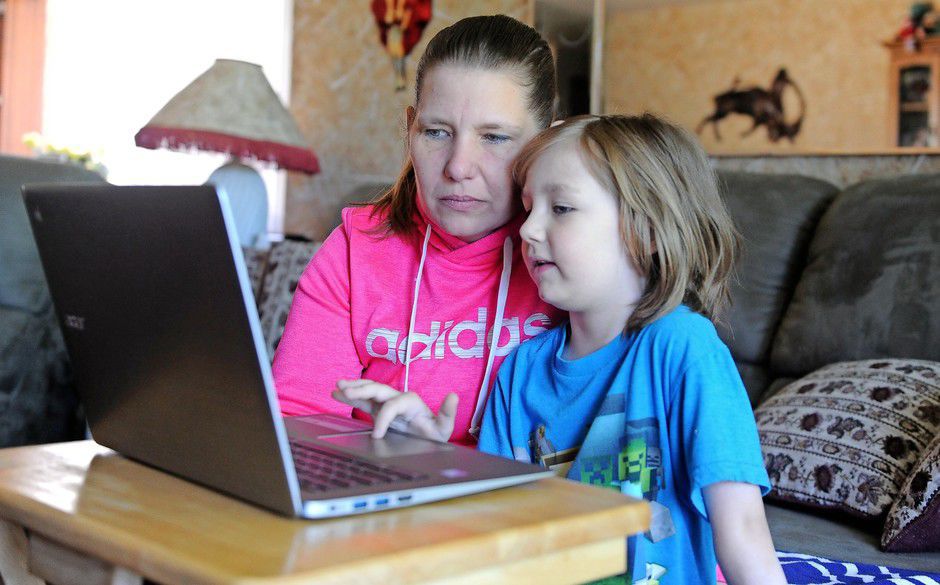For Jana Langhoff and her son Tyler, summer days don’t look drastically different from when their Medford elementary school was in session.
Tyler, who finished his first-grade year at home like the rest of his Howard Elementary School classmates amid Oregon’s statewide school closure, didn’t thrive while learning from a distance. And the catch-up instruction his school is offering him this summer won’t work much better, since his teacher still must connect with him over a computer instead of face-to-face.
Tyler, 6, had been settling into a routine just before the COVID-19 pandemic, but the ensuing restrictions disrupted that rhythm. If you ask his mother, she’ll tell you Minecraft has been a more effective teaching tool than anything his school offered him.
“I think it’s just not having the teacher there,” Jana Langhoff said. “Getting back in the classroom would be great. I know he’s falling behind.”
It’s that lack of connection that makes online summer school less appealing to the Langhoffs and to some older students as well. Citing the health risks of coronavirus, Howard Elementary’s leadership decided on an online-only model for its first summer school, available to students who need extra help preparing for the next school year.
Students of all ages, from kindergarten through high school, saw their quality of education lessened and academic trajectories slowed, with students in poverty and without stable housing most likely to have lost ground.
Distance OK for some, not all
But one group of Medford-area students is getting a new set of summer learning opportunities this year, a positive result of the school closure. The school district’s annual migrant summer school is offering career and technical courses for the first time.
Though COVID-19 precautions continue to affect delivery methods, the summer offerings in Southern Oregon’s largest school district are further-reaching than they’ve ever been, with expanded programming to support students spanning the K-12 system. Multiple schools have already launched virtual programs to remedy learning loss this summer.
A significant share of Medford high schoolers also struggled under the distance learning model during the final quarter of the school year, achievement data show.
This spring while studying at a distance, Medford high school students achieved a passing grade in 81% of their classes, a rate nine percentage points lower than in the previous quarter. And students in low-income households or without stable housing managed to pass at lower rates: Students who are considered socioeconomically disadvantaged passed 73% of classes they took in the fourth quarter, and students experiencing homelessness passed 71%.
“All of the data that we’ve gotten show that distance learning just doesn’t work well for our most vulnerable students,” said Natalie Hurd, communications specialist for the district.
Throughout the spring school closure, school officials counted how often students checked in with teachers and completed assignments, giving them a portrait of which students were engaging with school despite not being able to come to campus.
In Medford, those data indicated that 97% of students connected with online learning throughout the spring, said Jeanne Grazioli, Medford’s executive director of teaching and learning.
But there’s considerable nuance in that figure, ranging from students who were regularly engaged to those who connected with a teacher only once or a handful of times over several months.
Natalie Schroeder said her daughter Allison, a second-grader at Ruch Outdoor Community School, was still able to learn effectively at a distance. A substitute teacher who lost work when the closures hit, Schroeder turned to helping her daughter stay in a routine. Money was tight as her husband also lost his job in the pandemic, but Allison “did OK” overall, she said.
But awareness of the challenges that distance learning posed for so many other students, as well as some leftover funds, led to Medford’s bulked-up, but largely online offerings for summer school.
Migrant students get hands-on
Participants in Medford’s annual summer school for migrant students, however, are getting expanded in-person instruction. For the first time, the program includes career and technical courses, including welding, engineering and manufacturing.
Silvano Pineda, an incoming ninth-grader, said his first two weeks in a welding class have been “the greatest experience.”
From noon to 4 p.m. Monday through Thursday, Jesse Holcomb, a manufacturing teacher at South Medford High School, leads Pineda and his classmates through the basics of the trade. The students begin by reviewing measurements and conversions before donning jackets and hoods for the hands-on portion of class.
“It’s really fun learning something new,” Pineda said. “You can definitely learn more like this than just sitting down.”
Leftover federal funding for migrant education that wasn’t spent during the school closure this spring helped make the career-related courses, with their small student-teacher ratios, possible this summer.
For migrant students, whose elective choices may be limited during the school year from fitting English language classes in their schedules, the summer career classes offer unique opportunities.
“The class is smaller, which is great, because then we can get more one-on-one time,” Holcomb said. “They get more time working. And so they actually have an advantage over the normal school year.”
The federally funded summer school, which Medford has hosted for nine years, supports students from migrant families who frequently move across district, state and even national boundaries with the tides of seasonal work.
High mobility and poverty are just a couple of the barriers that can affect migrant students’ education. Making career-tech experiences accessible, officials said, offers a path to what they call “high-skill, high-wage, high-demand” jobs.
Extra federal funding also contributed to three Medford elementary schools offering broadened summer learning opportunities.
“We don’t traditionally hold a summer school for elementary,” Grazioli said. “But a few of our Title I schools have decided to do an extended learning plan, where they have a lot of kids working online with a teacher, continuing to do that work over the summer.”
With squirts of hand sanitizer to greet them as they enter the campus and physical distancing measures firmly in place, summer school students are getting a jumpstart on the formats and precautionary measures expected to be in place for the fall.
Earlier in June, the Oregon Department of Education and the Oregon Health Authority jointly released guidelines for K-12 school districts for the upcoming school year.
Detailed safety plans, which officials in Medford and other school districts are now formulating, will spell out how students will be kept properly distanced from each other and staff in classrooms, how surfaces will be regularly sanitized, and how staff and students who need to remain at home will be accommodated.
Whether their students weathered the closure with a little or a lot of difficulty, many employees’ and parents’ preference seems to be some kind of a return to the classroom.
“I think it’s really important to do whatever they can to get the kids back in the building somehow,” Schroeder said. “That socialization, the interaction they have with the teacher is so important. I saw that for sure in these last couple months.”

